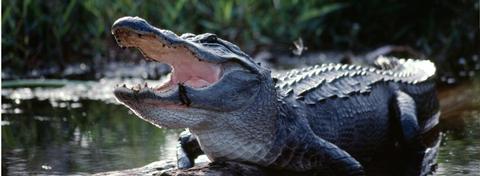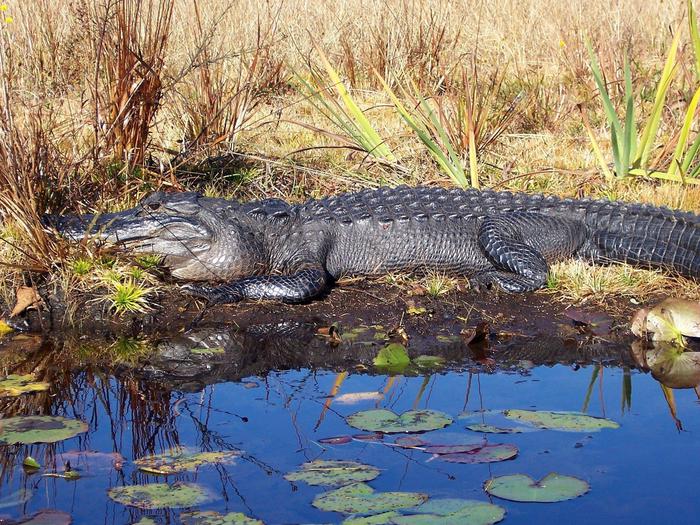Okefenokee National Wildlife Refuge
The Okefenokee National Wildlife Refuge was established in 1937 as a "refuge and breeding ground for migratory birds and other wildlife.” The refuge conserves the unique features of the Okefenokee Swamp,the headwaters of the Suwannee and St. Marys rivers. The swamp provides habitat for threatened and endangered species, such as red-cockaded woodpeckers, wood storks, indigo snakes, and a wide variety of other wildlife species. It is world renowned for its amphibian populations that are bio-indicators of global health. More than 600 plant species have been identified on refuge lands. Today, the refuge is approximately 407,000 acres and is the largest National Wildlife Refuge east of the Mississippi River. In addition, the refuge is a Wetland of International Importance (RAMSAR Convention – 1971) because it is one of the world’s largest intact freshwater ecosystems. Nearly 359,000 acres of Okefenokee National Wildlife Refuge are assigned as Congressionally-designated wilderness. The legislation that created the Okefenokee National Wildlife Refuge wilderness area (353,981 acres) grandfathered in historic uses such as fishing and the use of motorboats up to ten horsepower. It also required the USFWS to maintain four access areas and up to 120 miles of trails. A small number of National Wilderness Areas have additional protection as Class I Air Sheds under the 1990 Clean Air Act. Okefenokee is one of only 21 refuges across the country with this additional designation. Historically, the Okefenokee was the indigenous homeland of the Deptford and Swift Creek Cultures, Weeden Island Culture, Cord-Marked Culture, Timucuan people, and the Seminoles. The Okefenokee Wilderness was designated in 1974 and has a total of 353,981 acres. The Okefenokee Wilderness is managed to restore, preserve, and protect the primeval character and natural processes of the designated lands, leaving it untrammeled by man while providing recreational solitude, education, scientific study, conservation ethics, and scenic vistas. Okefenokee National Wildlife Refuge and Okefenokee Wilderness encompasses the best-preserved precipitation-based freshwater wetland ecosystem in the conterminous U.S. and the largest in the Northern Hemisphere’s subtropical zone. It is the last-standing large, naturally driven freshwater wetland in the eastern U.S. The resiliency of its diverse habitats from open lakes, marshes, scrub-shrub, cypress and hardwood forests, to pine islands resembling pristine conditions stands out in one of the highly populated and developed temperate/subtropical regions of the world. Designated as a Wilderness Area, management strives to allow ecological processes to govern in order to sustain the ecosystem services it has provided for centuries. Learn more about the Okefenokee Wilderness
Directions to the Main Entrance (Suwannee Canal Recreation Area). Do not depend on GPS to navigate to the refuge. Please follow directions below. (Main Entrance- Latitude N 30.73870100, Longitude W -82.14000600) Directions from Folkston, Georgia: Turn onto Main Street heading west. Go through two stoplights and across the railroad tracks. Take a left at the 3rd light onto Okefenokee Trail (Parkway), also called GA 121/23 South. Drive approximately 7 miles, then turn right at the large, beige “Okefenokee National Wildlife Refuge” sign. Follow this road about 4 miles to the end. When you reach a large parking area, you will see the Richard S. Bolt Visitor Center on your left. Okefenokee Adventures is located next to the boat basin. Directions from Jacksonville International Airport: Depart the airport terminal on the airport road which turns into Dixie Clipper Road. Take Dixie Clipper Road to I-95 Northbound. Follow the directions from Interstate 95, Exit 3 (below), to get to Okefenokee. Directions from Interstate 95, Exit 3: Take GA 40 West approximately 22 miles through Kingsland to Folkston. Where GA 40 dead-ends at a T intersection, turn right onto Third Street then take the next immediate left onto Main Street (courthouse is on your right at turn). Follow directions from Folkston, GA listed above. Directions from Atlanta, GA area: Take Interstate 75 South out of Atlanta. In Tifton, take US 82 East towards Waycross. Stay on US 82 East all the way into Waycross. Turn Right onto US 1 South in Waycross heading towards Folkston. You’ll pass the Okefenokee Swamp Park along US 1 South. Continue driving on US 1 to Folkston. Once you enter Folkston, turn right at 2nd light onto Main Street. Follow directions from Folkston, GA listed above. Directions from Brunswick, GA area: Take I-95 South towards Kingsland. Take Exit 3 off I-95 and turn West (Right) on GA 40. Follow directions from Interstate 95, Exit 3 listed above. Follow directions from Folkston, GA listed above. Directions from Interstate 10 and St. George: Take exit 48 from I-10 onto FL 121 North. Drive north on Fl 121 approximately 20 miles until you reach St George, GA. The road designation will switch to GA 121/23 when you cross over the St. Marys River into Georgia. Proceed north approximately 14 miles until you see the Okefenokee National Wildlife Refuge” sign. Turn left and follow this road about four miles to the Richard S. Bolt Visitor Center.


